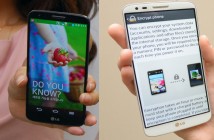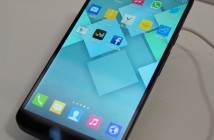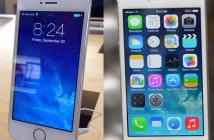
Samsung is currently the number one manufacturer of smartphones in the world – ahead of such giants as Apple and Nokia, which is a very impressive achievement. Their Galaxy S smartphones have sold over 10 million units, and both the Galaxy S and Galaxy S2 are among the world’s most popular and recognized Android phones.
The Galaxy S2 is still a very good handset, but its successor, the Galaxy S3 is already here and it brings a few noteworthy improvements. If you’re in the market for a new phone that is great news, but if you already own a Galaxy S2 (especially if you bought it recently), you’re most likely wondering if it’s worth upgrading to the new model. Let’s take a close look at what the new Galaxy S3 brings to the table and how it compares to its predecessor in order to make the best decision.
Design
The Galaxy S2 is one of the most popular phones, and it owes a big part of that to its design – when it was released a year ago, it was one of the most beautiful phones in the world, with a very slim 8.5mm profile and a classic look that still looks good today and will never get old, for that matter. But I have to say that the Galaxy S3 completely blows that out of the water – this phone is just ridiculously attractive, while still remaining practical in use.

The phone is a mesh of Samsung’s other designs, including the Galaxy S and Galaxy Nexus, and even with the latest and greatest hardware under the hood and a beautiful, huge 4.8 inch HD display, it is still only 8.6mm thick and more importantly, 70.6mm wide (which means it fits well in the palm of your hand). Samsung also did the impossible by making this design unique enough to avoid being sued by Apple again, as was the case with the first two Galaxy S phones (Apple sued them for using the square design with rounded corners, which frankly, is completely stupid, but they still won the case in a lot of courts).
The Galaxy S3 comes in white and dark blue, with the latter being more attractive in my opinion, thanks to its pebble/brushed metal finish on the front and back. Samsung left the external navigation buttons intact, but thanks to the physical home screen button in the center, you won’t have any issues with accidentally activating the touch sensitive buttons while holding the phone with two hands.
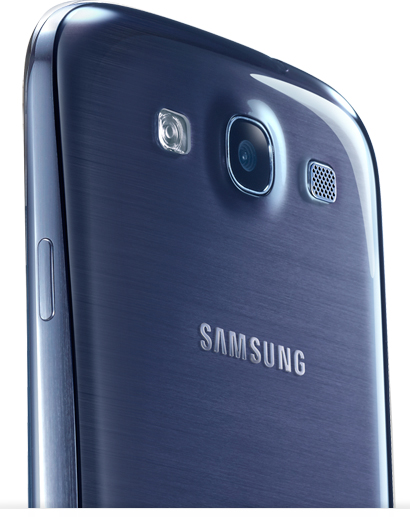
The build quality of the new Galaxy is a bit disappointing – many were expecting a metal or even ceramic housing – instead, Samsung went with good old plastic all around the phone (with a new glossy finish) and a Gorilla glass sheet on the front. As a result, the Galaxy S3 feels a bit cheaper than the Droid RAZR or iPhone 4S, for example, but it’s still sturdy enough for everyday use and for its size, it’s very light. The Galaxy S2 and S3 are very close in build quality – they’re not the best of the best, but they’re not crumbling in your hand, either.
![]()
Hardware features
The Samsung Galaxy S2 had impressive hardware when it was launched, and it’s still more than good enough for even the most advanced power users. It even got an upgrade along the way in the form of NFC in select models. It’s dual core Exynos processor running at 1.2 Ghz and the Mali 400 GPU are among the top performers on the market, and they definitely make everything run smooth as butter. Even the display is pretty damn good, considering it’s 4.3 inches in size and has a resolution of only 800×480 pixels – the only thing saving it from pixelation is the Super AMOLED Plus technology, which uses a full RGB matrix to display some of the best colors on a smartphone.
Obviously, the new Galaxy S3 is no slouch – as a successor, it needs to offer something better than the above specs, and it does: not only does it have built-in NFC from the get go, but it also packs the all new quad core Exynos 4 Quad chipset, with the processor cores running at 1.4 GHz and the Mali 400MP featuring multiple cores, as well. As you may have noticed, it is pretty much double the performance of the Galaxy S2, and the benchmarks prove that to be right. The amount of RAM stays put at 1 GB, just as its predecessor, but apparently it’s more than enough for today’s applications.
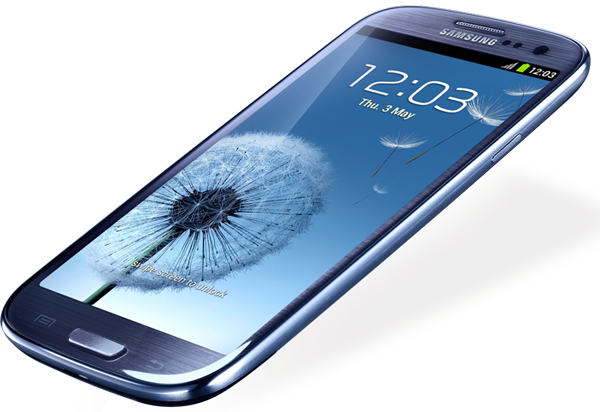
Samsung managed to fit a stunning 4.8 inch display inside a housing that is just a bit wider and 1cm longer than the GS2, and thanks to the 1280×720 pixels resolution, the image is simply stunning. Thanks to the PenTile technology, you won’t be seeing an increased battery usage from the screen – in fact, it uses less energy than the Super AMOLED Plus unit.
The battery life should not be a problem thanks to the removable 2100 mAh battery – expect to see extended batteries available soon after the phone hits the market. The other hardware specs of the Galaxy S3 remain similar to its predecessor. You can see and compare the full specs list in the table below:
Samsung Galaxy S2 vs Galaxy S3 specs comparison table
| Samsung Galaxy S II | Samsung Galaxy S III | |
|---|---|---|
| Display | Super AMOLED Plus, 4.3 inches, 800×480 pixels, 217 DPI | HD Super AMOLED, 4.8 inches, 1280×720 pixels, 306 DPI |
| Processor | Exynos 4 Dual, 1.2 GHz | Exynos 4 Quad, 1.4 GHz |
| RAM | 1024 MB | 1024 MB |
| Graphics Adapter | Mali-400MP – dual core | Mali-400MP – quad core |
| Storage Space | 16/32 GB built-in, micro SD card slot for up to 32 GB cards | 16/32/64 GB built-in, micro SD card slot for up to 64 GB cards |
| Camera(s) | Back – 8 MP with 1080p video recording; Front – 2 MP | Back – 8 MP with 1080p video recording; Front – 2 MP |
| Connectivity Options | HSPA+, Wifi N, Bluetooth 3.0, LTE and NFC (select models only), USB, HDMI, DLNA GPS | HSPA+, Wifi N, Bluetooth 4.0, LTE (select models), NFC, USB, HDMI, DLNA, GPS, GLONASS |
| Sensors | Accelerometer, gyroscope, proximity, light, magnetometer | Accelerometer, gyroscope, proximity, light, magnetometer, barometer |
| Battery | Li-Ion, 1650 mAh, up to 8 hours continuous use on 3G | Li-Ion, 2100 mAh, up to 10 hours of continuous use on 3G |
| Dimensions and weight | 125.3 x 66.1 x 8.5 mm, 116 grams | 136.6 x 70.6 x 8.6 mm, 133 grams |
| Operating System and Software | Android 4.0 (via OTA update), Touch Wiz 4.0, Live Panel, Adobe Flash, Wifi Direct, AllShare, Samsung Hubs, On-Device Encryption, VPN | Android 4.0, Touch Wiz 5.0, Samsung Hubs, Adobe Flash, Live Panel, Wifi Direct, AllShare, On-Device Encryption, VPN, Smart Stay, Direct Call, Smart Alert, Social Tag, S Voice, S Beam |
Software features
The software features of both the Galaxy S2 and Galaxy S3 are comparable, but the S3 brings quite a few improvements to the table, especially for the average user. Both smartphones run Android 4.0 Ice Cream Sandwich (the S2 has it available as an OTA update), both are very smooth (we’re talking iPhone 4S levels of smooth – the S2 and S3 are nothing like most other Android phones, they have no lag anywhere), and both use Samsung’s Touch Wiz UI and Hubs (Reader, Media, Social, etc.) apps.
Obviously, the Galaxy S3 has a few things that are exclusive to it, at least for now. The most important additions are the Touch Wiz 5.0 UI – a completely revamped interface, with a more organic look and a nature theme. It’s quite beautiful and intuitive to use, indeed, and it’s a definite improvement over Touch Wiz 4.0. Unique to the Galaxy S3 are the Smart Stay, Smart Alert, Direct call, Social Tag, S Voice and S Beam features, plus Samsung added a few new capabilities to the inbuilt cameras.
Let’s break these features down and see what they have to offer:
– Smart Stay – Using the front facing camera, the phone keeps the screen on for as long as you look at it and turns it off to save battery if you have taken your eyes off of it for a while;
– Smart Alert – Using the accelerometer/gyroscope sensors, the phone keeps track on when you pick it up and vibrates, rings and otherwise notifies you of any missed calls, new messages, new updates or anything else. No more useless ringing or vibrating for missed events when you’re not around the phone (which also saves some battery);
– Direct Call – This feature uses the integrated proximity sensor to place a call to the number or contact on screen without you having to tap any buttons. Sadly, it only works with Samsung’s own apps, but developers can add the functionality to other apps, as well;
– Social Tag – The phone can show you quick information about any of the people it recognizes on photos – for example, if you’re looking at the photo of a relative, it will give you options to call, email or otherwise connect with them, provided you have the person in your contacts list with all the relevant information;
– S Voice – This is the feature everyone talks about. S Voice is basically Samsung’s equivalent to Apple’s Siri, and it works quite nicely, indeed. It can do a lot of things – set alarms, find contacts and information, display maps, remind you of anything, and more – if you’ve seen Siri in action, you know what to expect of S Voice;
– S Beam – S Beam lets you share anything with another Galaxy S3 user by simply putting the phones back to back – the level of seamlessness is pretty awesome, and it definitely makes it a breeze to exchange contacts, photos, documents or anything else.
Samsung put a lot of thought into the software of the Galaxy S3 – the features above are only the biggest ones. The S3 also has a lot of other minor improvements and feature snippets here and there (the camera being able to take photos while recording video being a great example), and together, they make the experience more organic, intuitive and richer – it’s pretty awesome.
I have no doubt that the Galaxy S3’s unique software features will become available for the S2 and even older phones with the help of all the modders and developers out there (after all, the necessary sensors are already in place), but only S3 users will be able to enjoy them for the first several months.
What does the S3 offer to the average user?
Let’s make this simple: you’re a normal user and are in the market for a new phone, preferably one that has all the bells and whistles and will be top of the line for a long time. Why should you go with the Samsung Galaxy S3? Here’s what the phone offers for you:
– A big, beautiful display inside a relatively compact housing. The display is the main component of smartphone and can make or break it. The Galaxy S3’s screen is definitely one of the best ones on the market, and you don’t have to put up with an annoyingly big and unwieldy phone in order to have it in your pocket – the S3 is just a bit larger than the S2, and it actually fits better in your hand;
– A powerful quad core processor and quad core graphics adapter. The quad core Exynos chipset is more than enough for any kind of use and will be actual for many years. In fact, the Galaxy S3 is more powerful than ALL of the tablets released in 2011 and most of the tablets released this year – no matter what anyone else has and is bragging about, you can rest assured your device is more powerful. That doesn’t come at any expense, either – the battery life is just as good as a dual core smartphone in normal use;
– A host of unique software features that make the experience near perfect. Samsung paid a lot of attention to the software that went inside the Galaxy S3 – the Android Ice Cream Sandwich OS, coupled with the all new Touch Wiz 5.0 and the unique features listed in the previous paragraph make the smartphone experience as good as it gets;
– A lot of internal memory plus a micro SD card slot. The Galaxy S3 comes with 16, 32 or 64 GB of onboard Flash storage space, but if that’s not enough, you can easily pop the cover and insert a micro SD card up to 64 GB in size – this makes the S3 pretty much bullet-proof in that regard. You can get the 64 GB model for the most storage space, or you can save money by choosing the 16 GB model, then getting a cheap 32 or 64 GB micro SD card when you need more space in the future – it’s your choice;
– A big, replaceable battery. Battery life is a problem for most of today’s smartphones, but the Galaxy S3 stands above many other devices in this regard. The phone can last up to 10 hours of continuous use (video playback, gameplay or document editing) on 3G using the stock 2100 mAh battery, which is more than the iPhone 4S. If you stress the processor, the time goes down to around 6 hours (in heavy Web browsing or intensive apps), which is still more than any other quad core phone and on par with the iPhone 4S. Moreover, the battery is replaceable – you can buy an additional spare battery or go all out and get a big 3500 mAh unit for heavy duty work (the new back cover will make the phone thicker, though);
There are plenty of things that make the Galaxy S3 a worthy choice for the user who wants to get a smartphone that will last for years to come or just wants the best model that the market offers. The price is quite high, of course, but the Galaxy S2 had about the same cost when it launched and if the phone is subsidized to the same price as the competition, there really is no reason not to choose it.
What does the S3 offer to advanced users, modders and developers?
If you’re not an average user and prefer to have full control over your phone or you want to use it as a test bed for your applications and modifications, the Galaxy S3 is still a very good choice. Fortunately for all the modders and developers out there, the Galaxy S3 will have an unlocked boot loader, so you can flash any ROMs and mod your phone in any way you want.
The Galaxy S2 is a great phone in that regard – once you’re rooted, you can install custom ROMs, clock the processor for better performance or longer battery life, install any apps (including those unique to other phones, like HTC Sense) and do a lot of other things. The same applies to the Galaxy S3 – once the phone is out and the community gets going, it will be a leading device for modders, hackers and developers. The host of unique software and hardware features will undoubtedly attract many power users, as well.
Is the new Galaxy S3 worth upgrading to if you already have Galaxy S2?
Now that we’ve gone through all of the features of the Galaxy S3 with a fine-toothed comb and compared them to the Galaxy S2, it’s time to answer the question: what do you do if you already have a Galaxy S2? Do you upgrade right away? Do you wait a year or so for the S3 to become cheaper? Or do you skip it altogether and get the S4 when it comes out?
– If you’re a normal user who wants to have the best smartphone experience and you can afford to get the S3, there’s only one thing I can recommend – go for it! The Galaxy S3 is Samsung’s finest creation to date, and unlike the competition and the Galaxy S2, the software alone makes it worth buying (not that the hardware is lacking). It will be a very long time until the S3 is old – this phone is basically the iPhone 4 of the Android world.
– If you can’t afford it, I’d say you wait a couple of months – the price will go down and the networks will subsidize the phone and even offer trade-ins for current Galaxy owners. That’s when you go and get the S3.
– Of course, if you’re happy with the Galaxy S2, there’s little reason to upgrade – most of the software features will trickle down to the older phone in due time, and the S2 is already a great device, smooth and fast and suitable for any tasks – just don’t place your S2 and S3 on the same desk or you may fall in love with the S3’s display or design :-).
– Even if you’re a power user or developer and you can get all the software features that the Galaxy S3 offers through a custom ROM, the quad core processor and GPU, the big HD display and the battery are definitely going to be a heavy attraction and a good reason to upgrade – what modder/hacker doesn’t like the latest and greatest hardware?
Pricing and Availability
The Galaxy S3 is fast upon us – after a successful launch to critical acclaim and many pre-orders, the phone has already been set to be released on May, 30th in the UK, coming soon after in the US.
The price of the Galaxy S3 starts at 499 pounds (625 Euro or $795) for an unlocked 16 GB model, and if you get it with a contract, it goes down quite significantly. The S3 was one of the most awaited phones this year, and it doesn’t disappoint – placing it on the same table with an iPhone 4S will make the latter want to crawl (or vibrate :-)) off the table right away.

